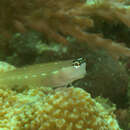Diagnostic Description
provided by Fishbase
Very similar to Ecsenius trilineatus in having white spots and thin dark lines. In E. schroederi there are two mid-lateral close together with a series of white spots between them (Ref. 48636).
Life Cycle
provided by Fishbase
Oviparous, distinct pairing (Ref. 205).
Trophic Strategy
provided by Fishbase
Occurs on sheltered reefs with rich coral growth (Ref. 48636).
- Recorder
- Grace Tolentino Pablico
Biology
provided by Fishbase
Adults occur solitary on sheltered reefs with rich coral growth (Ref. 48636, 90102). Oviparous. Eggs are demersal and adhesive (Ref. 205), and are attached to the substrate via a filamentous, adhesive pad or pedestal (Ref. 94114). Larvae are planktonic, often found in shallow, coastal waters (Ref. 94114).
Comprehensive Description
provided by Smithsonian Contributions to Zoology
Ecsenius schroederi
DESCRIPTION (certain counts and measurements for the holotype and only known specimen are given in Table 2; other data, with counts indicated for both sides, are as follows).—Gill rakers 14–14; pseudobranchial filaments 5–6; lower jaw posterior canine teeth 5–4. Lateral line with no paired pores.
Color Pattern: Head dusky, darker dorsally and anteriorly; distinct dusky postocular stripe extends from posterior margin of orbit to upper edge of opercle; an indistinct, thin dusky stripe extends across lower cheek onto opercle at level of mid-base of pectoral fin. Body pale with three wavy, dark pinstripes; dorsalmost pinstripe extends from supra-temporal canal posteriorly to base of twelfth segmented dorsal-fin ray; mid-lateral pinstripe is a continuation of postocular head stripe and extends posteriorly to caudal-fin base; ventralmost pinstripe extends from upper pectoral-fin insertion posteriorly to caudal-fin base. Three or four indistinct, pale spots present between mid-lateral and ventral pinstripes. Dorsal fin with concentration of dusky pigment along base, indistinct dusky stripe proximally, and dusky pigment extending outward along rays. Anal fin with dusky stripe on outer third of fin, tips of rays pale. Caudal fin with scattered dusky pigment proximally and along rays, interradial membranes clear. Pectoral fin with scattered dark pigment proximally; tips of five lowermost rays dark. Pelvic fin with scattered dusky pigment distally, otherwise unmarked.
RELATIONSHIPS.—Ecsenius schroederi and E. mandibularis are the only species of Ecsenius with more than two posterior canine teeth on each side of the lower jaw. E. schroederi can be distinguished from E. mandibularis by its very different color pattern and by having fewer segmented dorsal-fin and anal-fin rays (see “Key to the Species of Ecsenius”).
ETYMOLOGY.—Named for Jack R. Schroeder, whose excellent illustrations have so greatly enhanced the usefulness of our blennioid studies.
HOLOTYPE.—USNM 209743, male, 24.0 mm SL, Indonesia, Moluccas, Ambon Island, off Tandjung Suli, shallow coral reef, depth to 2.4 m, collected by V. G. Springer and M. F. Gomon, VGS 73-8, 11 January 1973.
- bibliographic citation
- McKinney, James F. and Springer, Victor G. 1976. "Four new species of the fish genus Ecsenius with notes on other species of the genus (Blenniidae, Salariini)." Smithsonian Contributions to Zoology. 1-27. https://doi.org/10.5479/si.00810282.236
Ecsenius schroederi: Brief Summary
provided by wikipedia EN
Ecsenius schroederi, known commonly as the Schroeder's combtooth-blenny in Indonesia, is a species of combtooth blenny in the genus Ecsenius. It is found in coral reefs in the western Pacific ocean, specifically in Indonesia. It can reach a maximum length of 7 centimetres. Blennies in this species feed primarily off of plants, including benthic algae and weeds, and are commercial aquarium fish. The species was named in honour of the wildlife artist and scientific illustrator Jack R. Schroeder (1954-2004).
- license
- cc-by-sa-3.0
- copyright
- Wikipedia authors and editors

